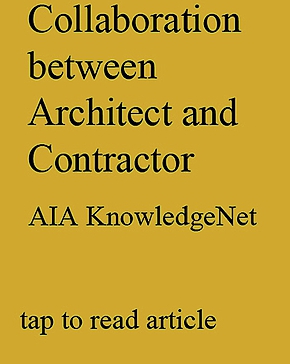Errors and Omissions Negotiations
By Paul Potts
Inexperience accounts for the conviction there shouldn’t be any mistakes in the architect’s plans and specifications. It is more logical there will be mistakes. The only pertinent questions are how many mistakes, how much will they cost in aggregate and who pays for them. Discussing the costs of errors and omissions during contract negotiations is the best way to keep this issue from corrupting the architect’s relationship with the owner.
The Initial Decision Maker
The architect’s construction administrator (CCA) will be negotiating on different fronts when errors and omissions are discovered: with the owner, with the contractor and possibly with their own staff. The first step. when a claim is presented, is to determine if the work in question has the basis for a claim. In making this determination the CCA will be acting as the Initial Decision Maker, a role described in Section 15 of the general conditions and Article 3 of the owner-architect agreement. The initial decision maker must be honest and fair when reviewing claims—not showing favor to one or the other party including their own masters. They must be a strict constructionist in this regard, carefully researching the contract documents to determine if the claim is valid.
Construction managers and general contractors can be facilitator or agitator when errors or omissions come up during construction. They have position because they spend more time with the owner than the architect’s representative (CCA) can afford and can cause trouble if they want. The best informed builders value collaboration with the architect and know there is nothing to be gained from making it more difficult for the architect-engineer to do their job.
Omission
The difference between an omission and an error is important when negotiating with the owner over costs associated with mistakes. An omission is needed work, equipment or materials that was mistakenly omitted from the plans at bid time. For example, a sidewalk from a building was required but was not shown, even though it had been talked about during programming. This is an omission; the contractor is entitled to a change order to place it. The owner will have to pay only once for the sidewalk, but, it is unlikely they will get it for the same price they would have gotten it on bid day. Change orders for omissions can in good conscience be referred to as a betterment or value added change orders.
Design Errors
A design error, on the other hand, is a mistake in the plans and specifications that requires replacement of already-built construction or equipment, with the original materials most likely being thrown away. In this case, the owner already paid for the work once and now must pay for it again as well as for any related demolition.
For example, the architect did not schedule a fire rated ceiling assembly in the music room of a high school auditorium where the space above ceiling was used as a return air plenum. This is a violation of the Life Safety Code®: According to NFPA 101® the ceiling should have been a fire rated assembly. The mistake was discovered by the fire marshal and the ceiling had to be demolished and replaced. The contractor was given a change order for the work.
Regardless of whether it’s an omission or error, mistakes in the architect’s documents will create friction with the owner. It’s best if the architect has a strategy to minimize conflict before the first error/omission change order is presented. Knowing how the owner’s representative feels about change orders in general is part of the strategy. Otherwise they may be bringing a match to a tinder box.
Code Compliance Change Orders
Code compliance change orders are in a category by themselves, because there is considerable latitude for code inspectors to make interpretations that can’t be easily anticipated by the architect-engineer at the design stage. If the architect attempts to anticipate the inspector’s every judgement, they may unnecessarily increase the costs of construction. If they try to be lean, there are likely to be violations that will have to be corrected by change order. It does seem the latter course is more economical but should be discussed with the owner.
Agency Plan Review
Government agency plan review is a service and not a guarantee that everything is in accordance with zoning ordinances and building codes. The building permit is not a license to ignore the building codes or ordinances. If there is a mistake by the architect that does not get the attention of the plan reviewer, the building inspector can tag it as a violation and order it corrected. Fortunately, some things that are not in compliance with the code are discovered by the contractor. For example, the electrician advised the architect that each piece of major equipment required an electrical disconnect in line of sight with the equipment and none were shown on the drawings.
There is the third possibility, potentially most costly oversight, that can ensnare even the most prudent architect-engineer. Plan reviewers and building inspectors for government authorities with jurisdiction are immune to claims for financial recovery if major code violations costing thousands of dollars to correct are discovered in construction after it was built in accordance with government approved plans and specifications.
For example, the plan department in The Village of Pumona, New York issued a building permit based on approved plans and specifications for the construction of an accessory building on residential property that exceeded the size permitted by the village zoning ordinance. After construction was well underway a “Stop Work Order” was issued by the building inspector, because the building exceeded a size restriction. Contrary to the owner’s contention in court, the village was not restrained in its power to stop work even though the village plan reviewer made a mistake in issuing the building permit. The village was in its lawful right to order the work stopped until the building was redesigned in accordance with the zoning ordinance.
Negotiations with the Claiming Contractor
For any work change issued after the contract is signed, the contractor has considerable leverage in negotiating the price. They are already mobilized on the site and unless the work described is at a separate location or clearly defined separately from the work already under way, it is difficult to see how a new, competitively priced contractor could be mobilized to do the work without resulting in litigation.
Under these circumstances the owner, the architect and the construction manager are caught in a situation where the contractor who quotes an inflated price for labor can justify it by saying “that’s the way I see it.” Prices for materials are easily confirmed, but the price for labor is in the eye of the beholder, even given the Means catalogue of labor costs. The contractor can simply refuse to do the work for less.
Thus, the contractor’s price for labor is very difficult to challenge successfully. The construction manager and the general contractor have more power and leverage to stare down the contractor than the owner or the architect, if they are willing to use it. They also have staff that can take off material and labor to provide comparison pricing.
One strategy is to challenge the contractor to do the work on a time and material basis. This will require close monitoring; and it is not a simple process without the assistance of the construction manager, unless the architect’s rep wants to spend several consecutive days at the site.
Reviewing Change Orders with the Owner
Before meeting with the owner to discuss an error or omission, the architect’s representative should become thoroughly acquainted with the facts of the mistake, know who is responsible and know the projected costs. Knowledge will impress the owner and help calm them down if they become expressive. Remind the owner of the contingency budget, some of it is there for situations just like this. Determine from the principal architect if there had been discussions during contract negotiations about errors and omissions. If there has been an agreement made during contract negotiations regarding some percentage of the contingency budget being set aside for errors and omissions, bring that up to bolster your negotiating position with the owner’s rep.
Conclusion
Every responsible construction budget has a 5 to 10 percent line item for contingencies that provides for hidden conditions, code compliance issues, owner’s requested changes and design errors and omissions it may just not be broken out like that. It should be enough to include 2 to 3 percent for errors and omissions. On some projects depending on the complexity and the contracting method (whether it is design-bid-build or design build) and whether the project is remodeling or new and whether it is a fast track project that percentage could be much higher.
The strategic time to discuss future costs of errors and omissions is during contract negotiations while the decision makers are still at the table. The owner has already gone to considerable lengths to engage the architect and it is unlikely they will break off negotiations over a realistic discussion about errors and omissions. Having that discussion before the owner-architect contract is signed is much more likely to have a positive outcome than waiting until the first change order is ready to be signed. By that time lower level owner’s representatives are in the position of decision making, laying the groundwork for a worse likely outcome. Lower level functionaries do not like making decisions and may be familiar with the standard of care and openly hostile to the idea that the architect should not have to pay for their mistakes.






